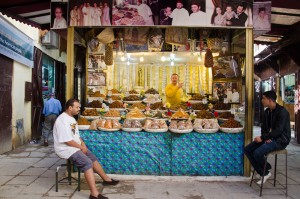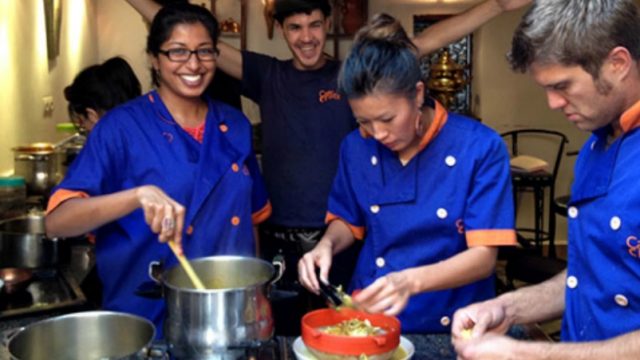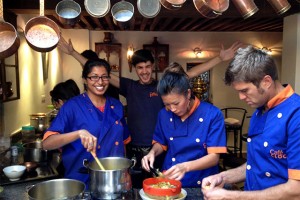Even before we reach our riad — a traditional Moroccan house with a courtyard — on a silent journey from Meknes with a surly but kind driver, I decide that I like Fez.
Leaving Riad Norma in the steep enclave of Ziat, we huff and puff at a hurried pace to our cooking class at Clock Café. We pass the Bab Boujeloud or blue tiled gate, and the sight of the market within the medina is arresting. The narrow cobbled streets are alive with the colors, smells, and essential rawness of market life — vendors hawking breakfast breads, vegetables, barrels of pungent olives and live chickens. But we are late, and cannot linger. Clock Café is in a slim alley lose to the clypsydra, Morocco’s only water clock, an ancient device that still tells time. Built in a restored 250-year-old house, this is a haven for locals and foreigners – a café and a center for cultural exchange.
We pass a small cinema and overhear someone order a camel burger – an essential must-eat here.
At the Clock Café, American exchange students and scholars — many can’t be older than 18 — are sitting at a table practicing Arabic. A couple leans in over a slice of cheesecake that the café has become famous for. Near the counter there’s a stack of fliers advertising yoga classes, henna tattoos, drumming and the belly dancing.
Our cooking class includes an athletic American couple who runs a window-cleaning company, and a spunky Malaysian researcher living in the U.K., travelling alone (her boyfriend “just doesn’t enjoy travelling” she tells us). Before we can cook, we need ingredients. Conveniently for us, everything can be found a few steps away.
Our young instructors are locals Mohamed Averroes — our translator — and chef Mohamed “Simo” En, who learned the trade from his mother and dreams of working in the U.S. They take us on an excursion through the stalls to their favorite suppliers.
The chicken vendor, unsmiling, dangles a fat chicken by the legs. Mohamed and Simo inspect it and approve.
“Thwack!”
It’s slaughtered in front of us and the Americans stare wide-eyed. We continue shopping while the chicken is cleaned.

Photo by Ishay Govender
Donkeys and mules laden with pails of milk and baskets of goods are led slowly through the streets, some whip-thin, others broader. We stop in our tracks at the sight of the doe-eyed, reluctant beasts. In the gentle lilt of Moroccan Arabic, the donkey minders shoo us out the way.
We sample a market breakfast of large flat breads such as harcha, the semolina pan-fried bread made with butter and milk with a spicy relish, olives and dates. Having skipped breakfast, we tuck in with gusto. Men and women in plain djebella are buying their breakfasts here too. I watch them keenly, taking in the easy conversations they are having with vendors, the patient haggling, the packages wrapped up and new customers moving in to the front.
It’s a rhythm of the everyday here in Fez. Food is bought fresh from a market, as it always has been. The customers know the vendors by name.
Some take items on credit, others hand out coins from small purses or handkerchiefs tied at the corner with a knot. I will return to this scene a few times to take my time browsing and picking spices like ras-el-hanout, preserved lemons, and the famous Fez blue ceramic vessels. It reminds me of shopping with my grandmother, except we were haggling at her local market in Durban, South Africa and I was still a little girl, circa the early ’80s. The word travel writers love to use here is “authentic”.
It’s clear our little troupe wants to linger at the market indefinitely, but there is a large menu to prepare. Mohamed and Sim usher us back to the class. Upstairs at Clock Café, we wash our hands vigorously and don the school’s dark blue cooking uniforms. For the next few hours we are occupied in the kitchen sharing the task of chopping, braising, mixing, kneading and stirring.
We elect from the menu options to make zalouk, the smoky spiced roasted aubergine dip; harira soup, a hearty soup found all over Morocco, and the delicate pastilla or bastilla.
This is what the café says about the classic pastry dish:
“Bastilla is made of fine layers of almost transparent pastry called warqa and is stuffed with pigeon and almonds. Although there are many famous forms of bastilla like seafood and ground meat-based bastillas, the most traditional and probably the oldest one is prepared (with) pigeons, but the latter is often replaced by chicken or other kinds of meat.”
Bastilla is unique in that it is both savory and sweet, using icing (confectioners) sugar, honey and orange blossom water. Despite my initial reservations, I discover it is a particularly scrumptious combination and demonstrates a complexity and sophistication in Moroccan cooking.
For dessert, we make a cookie with a cake-like texture known as ghriba, a honey macaroon of sorts. We take our pastries and dessert cookies to a feran or communal bakery (there is one located on almost every street) and wait while they brown in the wood fire oven at searing-hot temperatures.
The bakery charges less than $1 for a tray, and the baker is constantly inserting and removing trays with a large metal shovel. We spot breads, pastries, pies, and cookies. The aroma reminds us that it’s just past lunchtime. My tummy grumbles. The medina cats are also drawn to this fragrant hub of activity and they mewl at me in sympathy.
The man tending the fire knows which bread belongs to which family just by the shape of the bread. There are very few families who mark their breads or trays. It’s hard not to be amazed.
By this stage, the anticipation of the meal we’ve prepared over the past few hours gnaws at us. We remove our aprons, order cool drinks and are served the bountiful meal we prepared on the rooftop garden.
We end with glasses of syrupy-sweet mint tea, as one must in Morocco.




